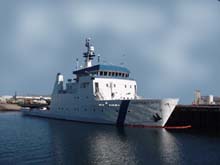
The M/V Independence at dock prior to its deployment to repair the hydrophone array.
Repairing the Hydrophone
April 24, 2002
Chris Fox, Director
Acoustic Monitoring Project
NOAA Pacific Marine Environmental Laboratory
This morning, real-time transmission of acoustic data from the Pioneer Seamount hydrophone array was restored. The hydrophone array, initially deployed in August 30, 2001, stopped providing acoustic signals on November 14, 2001 due to the failure of a critical electronic component. The repair to the hydrophone array was performed by scientists engineers from the University of Washington’s Applied Physics Laboratory from the M/V Independence, owned by the Naval Facilities Engineering Service Center in Port Hueneme, CA and operated under contract by MAR, Inc. Independence sailed from Port Hueneme on April 12th, with the weather at the Pioneer site predicted to be only marginal.
By the ship’s arrival in mid-morning on April 13th, however, the weather had improved and operations commenced. First, the seafloor package was located and the recovery buoy that had been deployed during the original installation in August, 2001 was released to the surface. The ship grappled the recovery buoy and then held position while the recovery line with the attached hydrophone array and undersea cable was brought to the surface. Fortunately there was essentially no entanglement of the recovery line with the hydrophones so that the operation went surprisingly smoothly. The hydrophone components were serviced and tested by sending electronic signals to an additional UW engineer stationed at the shore station at Pillar Point Air Force Station. One hydrophone element showed low signal levels that are currently being examined. After reassembly, the array was again deployed (with a recovery package in case of future failures) and began sending data late on April 13th.
Re-establishment of the real-time data transmission was hampered by an unusual occurrence: Mice had set up house in the shore side electronics during the down period. A new DSL router had to be purchased, programmed, and reinstalled, which was accomplished late on April 23rd by Dr. Roger Bland of San Francisco State University. PMEL could then begin providing again the data in real time. The data collected between April 13th and April 24th, as well as the earlier data set are available through ftp. The entire operation took only three days of ship time, although preparation was extensive. The Pioneer Seamount hydrophone array should continue to provide valuable acoustic data for many years into the future. The data are available for viewing.
Sign up for the Ocean Explorer E-mail Update List.









